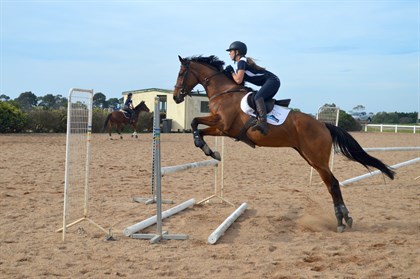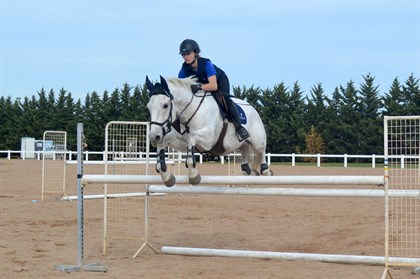|

|
This article has appeared previously with Equestrian Life. To see what's in the current issue, please click here

Ground poles can change the horse's line of sight
© Equestrian Life
A stockpile of brightly coloured wooden poles is a small slice of heaven for show jumpers, and not just to create elaborate courses. Just as the dressage rider uses various individual exercises to adjust and mould the technique of the horse’s paces for a more attractive and functional gait, so too can the showjumpers in using their tools of the trade.
BRING THE BASCULE
The trademark of the clear and careful showjumper is a well-crafted bascule. While some are born with the makings of this technique in their blood, there are several handy techniques great jumping riders keep in their training bank that can encourage the ideal jump shape for the seemingly effortless clear round. Bascule is the rounded, moving arc shape the horse’s body follows over any given style of fence. Just as a well-trained dressage horse eases around a corner like following a curving train track, without dropping a shoulder or hindquarter off the “tracks”, the jumping horse must follow the ideal bascule arc over the fence in a seemingly symmetrical way, rising up at the base of the fence, curving over the highest point of the fence and falling down in landing, mirroring the angles he made in take-off.
The most common error in a horse’s bascule is a sharper upwards trajectory in take-off, causing the neck to lock upwards at the highest point of the fence, as opposed to stretching downwards to begin the second half of the arc. Bring out your inner course designer to challenge this shape and encourage your horse to create a true Vivant-style rounded arc over the fence.
LOW WIDE OXER
Craft a wider, lower shape with your fence in the form of an oxer with a slightly greater width than height. This will encourage your horse to engage the muscular structure over his back (the topline) in forming a rounded arc shape over the fence. A low, wide oxer will encourage a lower forward stretching through the neck over the width of the fence, helping to take the edge off the “shooting upwards” feeling a horse with an imperfect bascule can give.
If you have ever likened your horse to a rabbit when jumping, the low, wide oxer is a great tool to break the habit of the “bunny hop”. You’ll feel your horse stretch forwards through your hands and you should follow this movement through to support this technique, without throwing yourself in front in a bid to help move him all the way over the wider obstacle.
If your horse is having trouble judging the width of the oxer in the form of knocking the back rail, place a pole over the top of both oxer rails on an angle to connect them, so that one end of the pole is rested on the front oxer rail and the other end on the back rail.
FOLLOWING GROUND POLE
Place a ground pole one stride out from your fence to realign your horse’s visual focus to the line he is travelling on. A following ground pole can encourage the horse to reach over the jump in a proactive way, as he pre-empts the following stride he will need to take following landing. You may just end up with a more forward thinking horse.
NEATEN UP
Picture-perfect showjumpers sport neat forelimbs over every fence. But keeping the front end of the horse in check over a fence serves a greater purpose of keeping rails up when it counts. History tells of Olympic showjumpers with knees meeting their ears, but the real goal is tucked up lower forelimbs so they do not “hang” down over the fence at risk of just tickling the rails and adding undesirable penalties.
One technique that is unfortunately etched in the training books, and especially encouraged with young horses, is letting the horse hit the fence with force to get them to understand that hitting poles hurts, with the intention of them being discouraged to do the same when it really counts. The more resounding lesson from this for your horse, is a blow to their confidence on course.
V OVER JUMP
Lean two poles up against your upright fence. Have the ends of the poles rest on the ground at the outer edges of the jump a couple of steps in front of the wings, with the other ends meeting in the middle a few inches above and resting against the top rail of the fence. When jumping, the horse should not adjust his arc to jump technically any higher than the original upright fence demands, but rather he should “tuck his toes” closer to his chest to accommodate the slight extra height the V poles add.
An innate bonus of this exercise is that it encourages your horse’s jump to be centred over the fence and at a right angle to the fence, helping to keep your desired striding between related lines in check.
ASCENDING OXER
An ascending oxer is defined by a higher back rail and is not uncommon on competition courses. However, it is also a handy tool for the at-home trainer. A higher back rail helps to encourage your horse to be aware of his lower forelimb placement, eliminating the lazy foreleg dangle as he travels over the fence.

An ascending oxer can help lift your horse's front legs
© Equestrian Life
Let’s not forget that the angle from shoulder to knee can play a role in the angle of the lower foreleg, so if you feel that you horse is not engaging a tuck that keeps his toes out of harm’s way, turn your ascending oxer into a style oxer. A style oxer is an ascending oxer with a more substantial height difference between front and back rails, and is overall greater in height than width, so that the horse is encouraged to lift his knees and snap his lower forelimbs up towards his chest more quickly without losing an even arc shape.
Remember that jumps that require technical accuracy that your horse may not be acclimatised to, may be harder than they first appear. Especially on your equine partner. While they may seem easy from afar, they require more than meets the eye. Your horse may need to draw on more energy, power and mental agility to successfully complete them in the first instance and won't understand what is required without your guidance and confidence. For this reason, only set up what you can look at and say, “We can do this”.
The ultimate show jumping technique needn’t be bound by breeding. Simple exercises can improve the form of your jump, ultimately improving its function for fewer dropped rails and a more economical use of your horse’s energy in increasingly technical show jumping courses.
|

|

